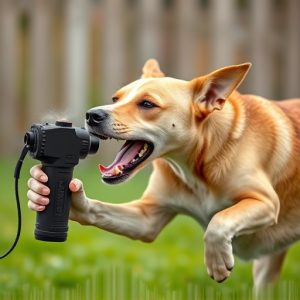Prevent Dog Attacks: Mastering Pepper Spray Technique at Safe Distance
Understanding canine body language is key to preventing dog attacks, as signals of fear or aggressio…….
Understanding canine body language is key to preventing dog attacks, as signals of fear or aggression can be missed. Pepper spray, a last resort, disrupts behavior by targeting eyes and nose within a 3-10 foot safe spraying distance. Proper training, including familiarizing with range and timing during aggressive behaviors, ensures safe and effective deployment.
“Dog attacks can be devastating, but taking preventive measures can save lives. This article delves into an unconventional yet effective solution: dog attack prevention pepper spray. We’ll explore the science behind how pepper spray deterrs dogs, focusing on understanding their behavior and triggers.
Learn the safe spraying distance for maximum effectiveness, ensuring you and your loved ones are equipped to handle potential threats. Discover how this tactic can be a game-changer in dog interaction, providing a powerful yet non-lethal defense.”
- Understanding Dog Behavior and Attack Triggers
- How Pepper Spray Works Against Dogs
- Mastering the Safe Spraying Distance for Maximum Effectiveness
Understanding Dog Behavior and Attack Triggers
Understanding a dog’s behavior is crucial when considering prevention methods, especially when it comes to attacks. Dogs communicate through body language and vocalizations, signaling fear, aggression, or territoriality. Recognizing these cues can help individuals avoid potential hazards. For instance, a dog’s hair standing on end, growling, or snapping are clear indications of discomfort or danger.
When it comes to pepper spray as a deterrent, knowing the safe spraying distance for dogs is essential. Aiming directly at the dog’s face or eyes from a close range (around 3-5 feet) can create a distraction and potentially stop an attack. However, proper training and handling are required, as incorrect use could cause unnecessary harm to both the dog and the handler.
How Pepper Spray Works Against Dogs
Pepper spray, also known as oleoresin capsicum (OC) spray, is a powerful tool in dog attack prevention. It works by targeting the dog’s sensory system, specifically the nose and eyes. When sprayed, the capsaicin in pepper spray irritates these areas, causing the dog to experience discomfort and temporary blindness. This disruption can help reduce the intensity of an aggressive response or even stop it altogether, allowing the person under attack to escape unharmed.
The safe spraying distance for dogs is crucial to its effectiveness. Typically, a range of 3 to 10 feet (1 to 3 meters) is recommended. At this distance, the spray can be applied directly to the dog’s face without causing serious harm or permanent damage. It’s important to note that pepper spray should only be used as a last resort when all other de-escalation techniques have failed. Proper training and understanding of its usage are essential for safe and effective deployment during potential dog attacks.
Mastering the Safe Spraying Distance for Maximum Effectiveness
Mastering the safe spraying distance is crucial when it comes to using pepper spray as a deterrent against dog attacks. Hold the can approximately 1-2 feet away from the dog, aiming slightly above its head. This allows for an effective cloud of spray to reach the dog’s eyes and nasal passages without risking inhalation or off-target irritation. Practice in open areas to become comfortable with range and dispersion patterns before relying on it in an emergency.
Remember, timing is key. Activate the spray when the dog displays aggressive behavior like barking, growling, or charging. The sudden sting of pepper spray can help disrupt the attack and give you valuable seconds to escape or seek help. Regular training sessions will ensure you know the correct distance and technique for safe and effective deployment during an actual encounter.
Dog attack prevention pepper spray can be an effective tool, but understanding its safe spraying distance is key. By mastering this technique, individuals can enhance their ability to deter potential threats and protect themselves in dangerous situations involving dogs. The safe spraying distance ensures minimal harm to the dog while providing enough time for escape or help arrival. Regular training and awareness of a dog’s behavior triggers are also vital to prevent attacks and promote a safer environment for all.


